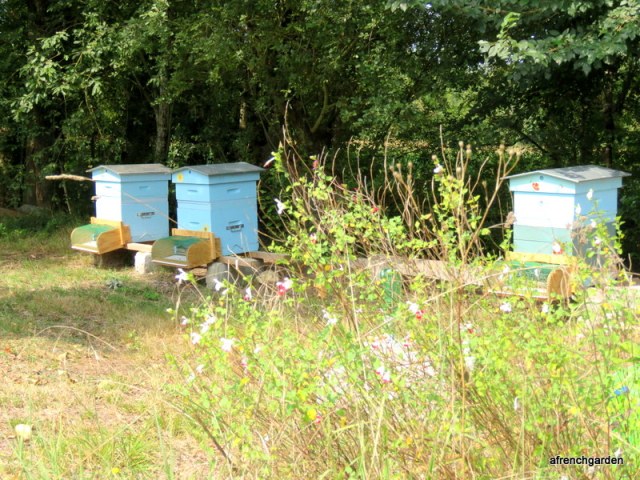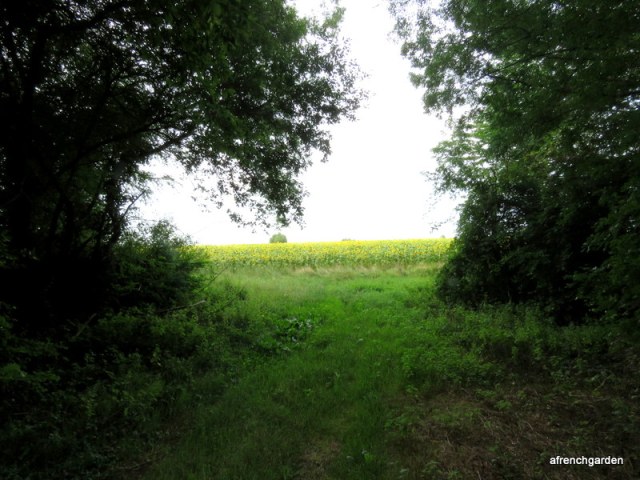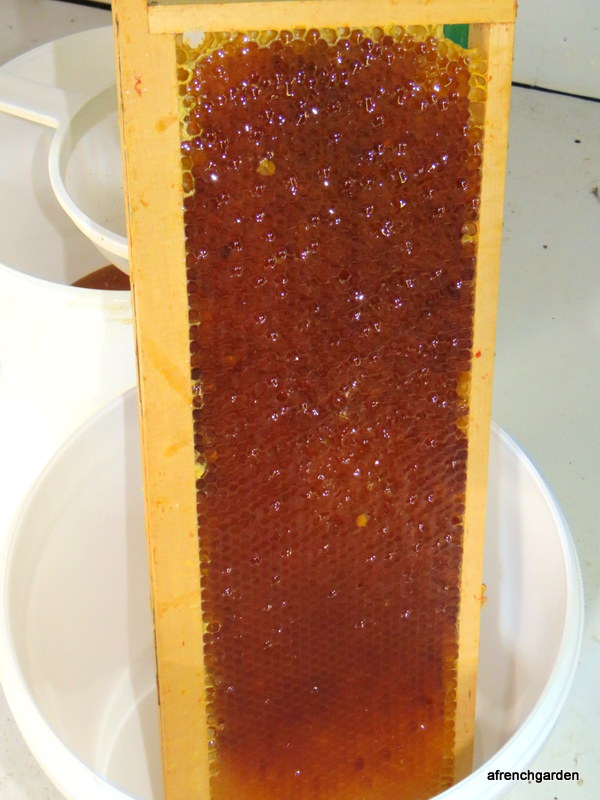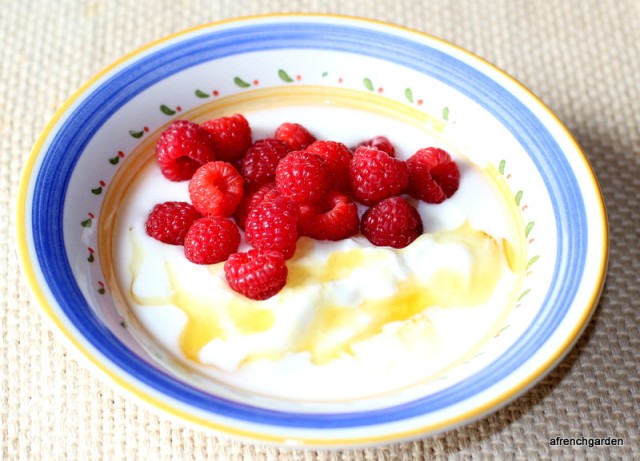It was first Violette and then pissenlit that we lost in May after they swarmed. In each case the story was the same. The colonies came out of winter very strong, but a week or so after they swarmed, the new queens did not manage to develop the colonies well.
I saw a bundle of bees on the grass in front of the hive

On close inspection Amelia and I saw the queen right in the middle, with the bees protecting her.

The story seems to have been similar with other beekeepers. I talked to another beekeeper near us with 44 hives and she had lost 11 colonies after they swarmed.
So, despite the fact that in May and June we collected 10 swarms and gave them all away, we started the summer in our own apiary with only 3 hives. Unfortunately when August came, the bees were once again attacked by the Asian hornets and I had to instal the modified muzzles with larger grills (1cm x 1cm) in front the hives to protect them. The hornets still come and take a few bees, but at least the rest are not so stressed.

The acacias flowered and then the chestnut trees all around our house. They were followed with the sunflowers. Just a short distance away I could look through the woods and see the fields of sunflower

A short walk and there laid before us the yellow field

We did check the individual flower heads, and true enough, our bees were busy.

At 6.45 am on 21st August Amelia and I removed the frames from the supers of all three hives and placed each of them in a separate plastic box and took them to my friend, Michel’s house for extraction. Michel was standing in the garden, waiting for us.
The first stage was taking each frame and removing the wax before placing them in the centrifuge. It was, however, immediately obvious that we had two distinct colour of honey; the darker one containing more chestnut honey was even more viscous. So we tried to keep the darker honey separate.
Once the wax was removed we saw beautiful glistening honey.

Soon after placing the frames in the centrifuge and starting the motor, the honey started to flow.

It is something truly amazing about honey. Depending on the flowers near us, we get different colour as well as different flavour of honey each season. Even the honey of our friend Michel who lives only a kilometre away is distinctly different from ours.
Last year we had really yellow honey that obviously a large proportion of which came from the sunflowers. Only two or three jars are left from last year. We gave a lot away and now I wish we had kept more for ourselves as the flavours of the individual honeys are so different and the yellow honey would bring sunshine into the winter days.
Last year’s honey is on the left of the picture below, with this years dark and light honey in jars. The second jar from left is our spring 2017 honey, which comes mostly from the spring flowers and also the rape seeds.

At the moment my favourite desert is the natural yogurt that Amelia serves with our own raspberries and a drizzle of this year’s honey. Delicious!

So another season has finished and a new season for the bees has started. We will do everything we can to protect our bees this winter and hope that the winter will also be mild and mellow for all of you.
– Kourosh

Keeping bees is an amazing window into another world. Thanks for the season’s wrap-up.
LikeLiked by 2 people
I am glad that you find it interesting. The bees never stop amazing me. _ Kourosh
LikeLiked by 1 person
+1 agree!!
Amanda | http://www.OrganicIsBeautiful.com
LikeLike
Thank you for posting, I enjoy following your blog and, as a beekeeper I am especially interested in your experiences with the Asian Hornet. We are just getting ready for the next invasion of the UK by this pest and I shall be talking to our local beekeepers about the Asian Hornet at the end of the month.
I too have heard that the larger mesh works better on the museliere, both 12.5mm x 12.5mm and also 25mm x 25mm as the bees can get in easier yet the hornet is reluctant to follow. Do let us know how you get on with it.
Please let me know if I could use your photo of the museliere in my presentation, it would not get distributed further.
Best wishes (and I was sorry to learn you lost one of your hives last year to the hornet)
Andrew
LikeLiked by 1 person
Thank you, Andrew.
Here we have tried a variety of methods to fight against the Asian Hornets. Other people have tried methods including poisoning the hornets and then letting them fly back to their nest. See attached (It is in French but I am sure you can follow it – especially see the video. https://natornatex.wordpress.com/2016/09/11/test-de-la-methode-israelienne-contre-le-frelon-asiatique/
As for the muzzles last year I found the smaller size mesh just was no good. Some bees just died trying to get in. So far I have found that the 1cmX1cm mesh works pretty good. The bees can enter easily. Theoretically the hornet should be able to enter but they are too scared. Meanwhile the bees are less stressed.
You are most welcome to use any of my material for display. I am also happy to share our experience.
Best of luck – Kourosh
LikeLike
So very cool. Makes me want to do this myself. Going to have to read up on the “how”.
Nice photos too.
LikeLiked by 1 person
Thank you for the comments.
All you need to do is pop over and Amelia and I will show you “how”. 🙂 _ Kourosh
LikeLiked by 3 people
Well that would be a dream. Where are you all at in France? Suz
LikeLike
We live in the Charente Maritime (department 17). Not far from Royan
LikeLiked by 1 person
Well this is too cool. Ma belle mère lives in Rochefort near La Rochelle (where she is from). I’ve been to la plage in Royan. It’s a very cool town. My husband and I hope to return in Sept 2018. Maybe we can check out the bees then.
Suz
LikeLike
Drop us a line in advance. You and your husband would be welcome to visit us.
LikeLiked by 1 person
Will do. Bonne journée!
LikeLiked by 1 person
It’s great how different all your honeys are. Honey on raspberries and yoghurt is one of my favourites too. Have you tried honey with soft cheese, Italian style?
LikeLiked by 2 people
Thanks, Emily.
I will certainly try soft cheese with honey. Honey is certainly so wonderful. I use it instead of sugar in cooking compotes. Also a spoonful of it in salad dressing makes all the difference. Best wishes to you. – Kourosh
LikeLike
A really interesting post. It’s amazing to see the different honeys next to one another and to observe the difference in colour/texture – and, no doubt, flavour. I understand how discouraging it is to lose colonies – we also lost one over last winter, although another one just moved to the empty hive right next door! (We don’t have many at the best of times.)
Beautiful dessert – and it’s so much more delicious when much of it is your own produce. We had honey for our Friday (weekend) breakfast today, served Egyptian-style with a flat and round, flakey-buttery pastry not unlike a croissant in taste… brilliant!
LikeLiked by 1 person
Thank you, Sylvia. I too used to enjoy many delicious food whilst visiting Egypt, many years ago.
I hope that your colonies do well this year. Best wishes – Kourosh
LikeLike
I hope the bees have an easy winter. Enjoy the honey!
LikeLiked by 1 person
Thank you
LikeLiked by 1 person
Wow, what an interesting, scary but productive year for you. Long may it last…Sue.
LikeLiked by 1 person
Thank you, Sue. One has to accept nature as it is. On the whole we are pleased with our honey collection and we hope the bees will do well this winter. One can always hope – Kourosh
LikeLike
A brilliant record Kourosh, and like you I’m fascinated by the variability in honey appearance and taste. Your images of the range of honeys your bees have produced is amazing. I’m very envious… What a shame you’re so far away. I’d love to try some!
best wishes
Julian
LikeLiked by 1 person
Well, that is easily solved. You must come over for a visit. Always welcomed.
Thanks for your comment. – Kourosh
LikeLiked by 1 person
I enjoyed reading your description of the “bee year”. I was intrigued by the color and apparent texture of the spring honey — is it thicker and creamier? I got some honey from a friend in Wisconsin (next state to the east of me), and it was very creamy and a pale yellow, although I don’t know when or from what flowers it was made.
LikeLiked by 1 person
Thank you very much, Sue. Certainly different honey has different viscosity. As each flow out of the centrifuge, we could easily notice the difference in viscosity, in colour as well as the taste.
The description of the Wisconsin honey straight away reminded Amelia of clover honey. I looked up on the internet and in fact Wisconsin appears to be famous for clover honey. Mind you only white clover is OK for the honey bees. Red clover, which is the favourite of the bumble bees has too long a style for the tongue of honey bees.
Of course nearly all honey comes from a variety of flowers and it is the mix that gives each honey it’s particular colour and flavour.
Talking of clover honey, last year Amelia and I passed a short holiday in the Limousin region of France. The lady of the house we were staying served us a lovely breakfast and I complimented her on the honey on the table. She laughed and said that it was actually not honey, but what they call in the country “poor man’s honey”. It was her clover jam! Delicious, it was.
Thanks again and regards – Kourosh
LikeLike
Thanks for the great information, Kourosh. White clover is sort of an abundant roadside weed in the upper Midwest so that makes sense for the origin of my friend’s honey.
LikeLiked by 1 person
There’s something very beautiful about your picture of the four honeys with the floral backdrop.
LikeLiked by 1 person
Philip
The comment on the picture, coming from you, is indeed a compliment. Thank you.
The cosmos this year have been beautiful and I could not resist placing the jars near them.
Regards – Kourosh
LikeLike
How sad to see the bees huddled over their queen like that. The photo highlights their vulnerability. They are lucky to have such good friends in you and Amelia. I love the photo of the 4 different honeys.
LikeLiked by 1 person
I talk to the older beekeepers. They remind me that when they started young, they could leave the bees alone most of the year. There was far less large scale agriculture and hence less pesticide. No Asian hornet (they came to France only in 2004 and have now spread even to the UK). So, yes you are right, our poor bees are very vulnerable. The pesticide not only kills them, but disorientates them and they cannot find their home or they get weak and die outside their hives.
We try and must continue to try harder, not only to protect our “girls”, but to try to educate our neighbours and friends.
Thanks for your comment. – Kourosh
LikeLike
Thank you, Kourosh, for the update . You continue to broaden my bee education. I wish you both…and your bees…a delightful and abundant winter.
LikeLiked by 1 person
Thank you, John,
And a very good winter to you, too.
LikeLike
Good to see you are enjoying the benefits of yours and the bees hard labourers. Ten swams from three hives is a lot to deal with, it must weaken the hives for the winter.
LikeLiked by 1 person
Brian, just to clarify a point, all our hives (in Spring we had four) did swarm and we caught the swarms. Other swarms came from elsewhere. That is quite common, as the presence of bee hives indicates to others that ‘hay, this is a good place to arrive!’
Thanks for your comment – Kourosh
LikeLike
Oh! I miss understood, I thought they had all come from your hives. I enjoy reading about your bees.
LikeLiked by 1 person
Interesting to hear your experiments with mesh guards and I’ll take note 1x1cm seems to work, although I hope our apiary never needs to use it. I’m glad that otherwise you are enjoying the world of a beekeeper!
LikeLiked by 1 person
Emma, I do hope that you never have to fight the beasts!
I changed my mesh from the original 6mmX6mm to 1 cm square and the bees are doing much better. The hornets still attack them, but the bees in front their hive are far less stressed. The important thing is to leave a little entrance in front of the hive.
Amelia and I are trying a variety of methods to fight the hornets, and I hope that we will manage better than last year. Only time will tell.
However, I am as always happy to share our experience.
LikeLiked by 1 person
Did you see that your blog was mentioned in the most recent BBKA News magazine? It was an article about Asian hornets and A French Garden was listed as a useful source of info.
LikeLiked by 1 person
Gosh! thank you for letting us know.
We subscribe to the French beekeeping magazines but a friend in the UK often gives us his past copies of the BBKA, which we have found extremely helpful. – Kourosh
LikeLike
I hope that I (or my bees) never have to fight them either, although sadly the Asian hornet has now been found in Devon: https://www.gov.uk/government/news/asian-hornet-identified-in-devon
So I was wondering where you got your mesh guard or did you make it? I think that I might prepare for the worst but still hope for the best! Best, Emma
LikeLike
Emma,
We bought our muzzles from a French charitable organisation. It is wooden but as I said i changed the mesh. The problem is that the majority of the hives in France are type Dadant which is slightly different size to the UK hives.
A major French beekeeping supplier who has just brought to market a plastic muzzle. I am not sure how it works, but worth looking at their site. https://www.icko-apiculture.com/fr/bouclier-anti-frelon-vespa-velutina.html
– Kourosh
LikeLiked by 1 person
Thank you, Kourosh. I’ll share that with my apiary. Hopefully, we won’t need to use it but I like to be prepared. All the best, Emma
LikeLiked by 1 person
How satisfying to enjoy your homegrown raspberries with your bees’ honey! I love the picture of the honeybees running around on the sunflower heads – the carder bees are not so gracious and were pushing each other off the sunflowers in our garden!
LikeLiked by 1 person
Thank you, Emma. I do hope that you are settling well in your new home and hopefully you have kept your bee suit ready and will start new adventures.
Do keep us posted. – Kourosh
LikeLike
Good job! Honey looks delicious, Your job is very nice! Thanks for sharing 🙂
LikeLiked by 1 person